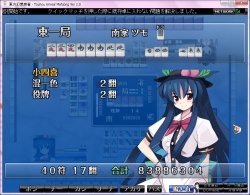Aotenjou
Aotenjou 「青天井」 is a rarely used scoring system where all limits are removed, meaning that scoring is entirely exponential.

Rule overview
Han is factored into the scoring equation as follows:
- Basic points = fu × 2(2 + han)
In the regular scoring system, this equation is capped at 2000 basic points (mangan), with higher hands being multiples of mangan.
In aotenjou, this mangan cap is removed, meaning that each han will double your score indefinitely. Due to the exponential nature of the scoring system, this can produce astronomically large point values. The modifiers for tsumo, ron, and dealer seat are then applied as normal, increasing the score further. For example, an 8 han 30 fu ron, worth 16,000 normally, is worth 122,880 in aotenjou. A yakuman ron (40 fu) is 32,000 normally and 5,242,880 in aotenjou.
In addition, yakuman are treated as 13 han yaku in aotenjou, so they can stack with regular yaku and dora. As with regular yaku, any yaku that are implied by the completion of a yakuman are not scored. For example, a suuankou hand does not score sanankou or toitoi, because these are prerequisites for suuankou.
Extreme scoring examples
- +
- This hand is scored as 13 han 40 fu (ron) or 14 han 30 fu (tsumo, counting mentsumo). By dealer, it is worth 7,864,400 (ron) or 1,966,080 all (tsumo).
- Agari: or
- With aotenjou, every aspect of this hand is considered, not just the yakuman patterns. This hand also includes the regular yaku of toitoi and sanankou as well as two or three yakuhai, depending on the seat. This hand stands at 31 han and 50 fu via tsumo:
Any dora to these examples definitely increases the hand even further.
Upper limit
Because a finite-sized hand can only score so many han and fu, there is a maximum score that a single hand can obtain in aotenjou.
In a hypothetical ruleset where double yakuman exist and are scored as 26 han, the maximum scoring hand would be as follows:
Assume the player is dealer, it's the East round, and has the yaku of riichi, ippatsu, tsumo, haitei.
This hand's fu value would be calculated as:
- base fu: 20 fu
- pair wait: 2 fu
- tsumo: 2 fu
- composition of hand:
Total 154 fu, round up to 160
The han value of this hand would be calculated as:
- tsuuiisou: 13 han
- suukantsu: 13 han
- suuankou tanki: 26 han
- riichi: 1 han
- ippatsu: 1 han
- tsumo: 1 han
- haitei raoyue: 1 han
- double east: 2 han
- dragons: 2 han
- shousangen: 2 han
- 40 dora: 40 han
Total 102 han
The base points value of this hand would be 3.25 × 1033 and the dealer would receive 6.50 × 1033 points from each player, for a total of 1.95 × 1034 points.
The highest possible fu count is 170, as in the following example for the south player in the south round:
- base fu: 20
- closed ron: 10
- pair wait: 2
- composition of hand:
Total 164, round up to 170
Yakuman/Yaku Compability
Certain yakuman imply certain yaku, and thus they cannot be scored together:
- Suuankou: Sanankou, toitoi
- Kokushi: Honroutou
- Daisangen: The three dragon yakuhai
- Tsuuiisou: Honroutou, chanta
- Daisuushii: Shousuushii, round wind, seat wind, toitoi
- Chinroutou: Honroutou, junchan, chanta, toitoi
- Ryuuiisou: Honitsu, If hatsu is forbidden: chinitsu
- Chuuren poutou: Chinitsu, honitsu
- Tenhou and chiihou: Mentsumo
- Suukantsu: Sankantsu, toitoi
These may be subject to further rule variation. For example, if daichiishin (Tsuuiisou + chiitoitsu) is considered an entirely separate yakuman, then regular tsuuiisou cannot score toitoi. The same applies to suuankou + mentsumo if suuankou tanki is its own yakuman.
External links
- 青天井 in Japanese Wikipedia